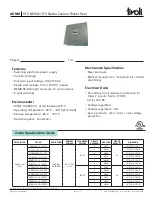
11
n
Tone Signaling*
When your system employs tone signaling (excluding CTCSS
and DTCS), this call procedure may be necessary prior to
voice transmission. The tone signaling employed may be a
selective calling system, which allows you to call specific
station(s) only and prevent unwanted stations from contact-
ing you.
q
Select the desired TX code channel according to your sys-
tem operator’s instructions. (Only
Simple and 10-key types
)
• This may not be necessary, depending on programming.
• Refer to the right column for the selecting procedure.
w
Push
[Call] (assigned to one of the programmable keys).
e
After transmitting, the remainder of your communication
can be carried out in the normal fashion.
n
TX Code CH Selection*
If the transceiver has
[TX Code CH Select] assigned to it,
the indication can be toggled between the operating channel
number (or name) and TX code channel number (or name).
When the TX code channel number (or name) is displayed,
[CH Up], [CH Down] or [CH Up/Down] selects a TX code
channel.
Not available on Non-display types.
USING [TX CODE CH SELECT] :
q
Push
[TX Code CH Select]— a TX code channel number
(or name) appears.
w
Push
[CH Up] or [CH Down], or rotate [CH Up/Down] to
select a desired TX code channel.
e
After selecting, push
[TX Code CH Select] to set.
• Return to the stand-by mode.
r
Push
[Call] to transmit the selected TX code.
USING [TX CODE CH UP]/[TX CODE CH DOWN]:
If the transceiver has a
[TX Code CH Up] or [TX Code CH
Down] key assignment, the programmed TX code channel
can be selected when pushed.
* These functions are usable with transceivers whose revision
number is 1.7 or later.
Selective calling
Non-selective calling
2
ANALOG MODE OPERATION















































